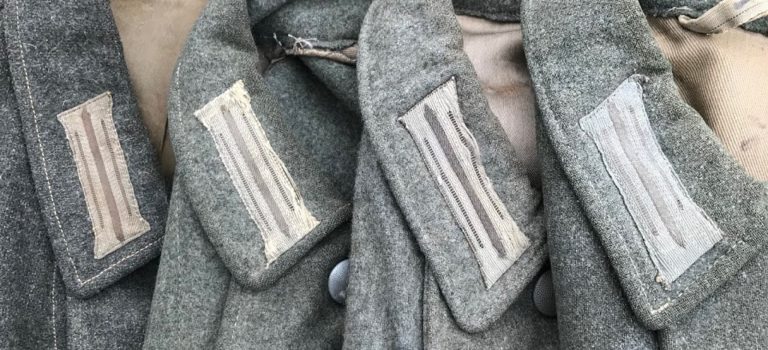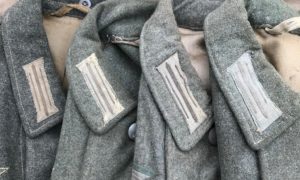Seven original unaltered wartime enlisted issue tunics were examined and measured to look at similarities and differences in the cut and tailoring.
Some aspects of the cut of each garment appear to be constant. The rear skirt is always shorter than the front skirt, between 1 inch and 2.5 inches shorter. The waist measurement across the front is always smaller than the armpit-to-armpit measurement, though this difference is small as .75″ and as big as 2.5″.
Other measurements vary widely from one example to the next. This should be no surprise. These garments were not sized as small, medium and large. Each garment was sized five different ways: the length of the tunic back, the collar size, the chest size, the overall length, and the sleeve length. These numbers varied independently of each other, as we can see looking at the original marked sizes on these examples. There is no direct correlation between the various sizes; a tunic could have a larger chest size but a shorter overall length. There is also no readily observable correlation between sleeve length and overall length. Two of the garments are stamped with a height range indicating they were suited for people who were 171-175 cm tall. These garments have different stamped sleeve lengths.
Some of the variation is surprising. Variation in pocket size and shape is remarkable. The proportions are not consistent. Some lower pockets are wider than they are tall. On others, it is the opposite. Futhermore, the measurement from shoulder to shoulder seems to vary in a way that does not correlate with chest size. I do not believe that wear and stretching or shrinkage could account for all of these variations. I believe that they were different when made, and that some of these differences are either unintentional, or were manufacturer variations.
Here are the numbers for each garment. Measurements were rounded to the nearest quarter inch. The numbering is arbitrary and doesn’t correspond to the photo. I have included the original stamped sizes for reference only. The sleeve length was measured on the M43 models only. Both of the worn M40 tunics had repairs to the sleeve ends that might have altered the original length.
Field blouse #1
Model: M40
Stamped tunic back length: 41 cm
Stamped collar size: 40 cm
Stamped chest size: 90 cm
Stamped overall length: 88 cm
Stamped sleeve length: 61 cm
Stamped height range: none
Measured shoulder width (seam to seam at the top): 16.75″
Measured arm hole height (top of shoulder to armpit): 8″
Measured armpit-to-armpit: 19.5″
Measured waist (across the front at the lowest belt hook hole): 18.75″
Measured chest pockets: 5″ wide, 6.25″ high
Measured lower pockets: 8.5″ wide, 8″ high
Measured sleeve length: N/A (repaired)
Measured front length (top of shoulder at collar to skirt end): 27″
Measured back length (base of collar to skirt end): 25.25″
Field blouse #2
Model: M40
Stamped tunic back length: 41 cm
Stamped collar size: 41 cm
Stamped chest size: 90 cm
Stamped overall length: 68 cm
Stamped sleeve length: 61 cm
Stamped height range: none
Measured shoulder width: 16″
Measured arm hole height: 9″
Measured armpit-to-armpit: 19″
Measured waist: 17.5″
Measured chest pockets: 5″ wide, 6.75″ high
Measured lower pockets: 8.75″ wide, 8.25″ high
Measured sleeve length: N/A (repaired)
Measured front length: 27.5″
Measured back length: 26.25″
Field blouse #3
Model: M43
Stamped tunic back length: 43 cm
Stamped collar size: 62 cm
Stamped chest size: 104 cm
Stamped overall length: 72 cm
Stamped sleeve length: 45 cm
Stamped height range: none
Measured shoulder width: 18″
Measured arm hole height: 9.5″
Measured armpit-to-armpit: 22″
Measured waist: 20.5″
Measured chest pockets: 5″ wide, 6.25″ high
Measured lower pockets: 7.75″ wide, 8″ high
Measured sleeve length: 23″
Measured front length: 27.5″
Measured back length: 26.25″
Field blouse #4
Model: M43
Stamped tunic back length: 43 cm
Stamped collar size: 43 cm
Stamped chest size: 96 cm
Stamped overall length: 72 cm
Stamped sleeve length: 62 cm
Stamped height range: 171-175 cm
Measured shoulder width: 16.5″
Measured arm hole height: 9″
Measured armpit-to-armpit: 21″
Measured waist: 18.5″
Measured chest pockets: 5.25″ wide, 7″ high
Measured lower pockets: 8.25″ wide, 8.75″ high
Measured sleeve length: 24″
Measured front length: 29″
Measured back length: 28″
Field blouse #5
Model: M43
Stamped tunic back length: 43 cm
Stamped collar size: 40 cm
Stamped chest size: 88 cm
Stamped overall length: illegible
Stamped sleeve length: 64 cm
Stamped height range: none
Measured shoulder width: 14.75″
Measured arm hole height: 9″
Measured armpit-to-armpit: 18″
Measured waist: 16″
Measured chest pockets: 5″ wide, 7.5″ high
Measured lower pockets: 8.25″ wide, 8″ high
Measured sleeve length: 25.5″
Measured front length: 29″
Measured back length: 28″
Field blouse #6
Model: M43
Stamped tunic back length: 43 cm
Stamped collar size: 42 cm
Stamped chest size: 92 cm
Stamped overall length: 72 cm
Stamped sleeve length: 64 cm
Stamped height range: none
Measured shoulder width: 16.5″
Measured arm hole height: 9.25″
Measured armpit-to-armpit: 19″
Measured waist: 17.25″
Measured chest pockets: 5.25″ wide, 7.25″ high
Measured lower pockets: 9.5″ wide, 9″ high
Measured sleeve length: 25.5″
Measured front length: 30″
Measured back length: 27.5″
Field blouse #7
Model: M43
Stamped tunic back length: 43 cm
Stamped collar size: 40 cm
Stamped chest size: 88 cm
Stamped overall length: 72 cm
Stamped sleeve length: 64 cm
Stamped height range: 171-175 cm
Measured shoulder width: 15″
Measured arm hole height: 9.5″
Measured armpit-to-armpit: 17.25″
Measured waist: 16.5″
Measured chest pockets: 5.25″ wide, 7.5″ high
Measured lower pockets: 8″ wide, 8.75″ high
Measured sleeve length: 25″
Measured front length: 29.25″
Measured back length: 28.25″


























